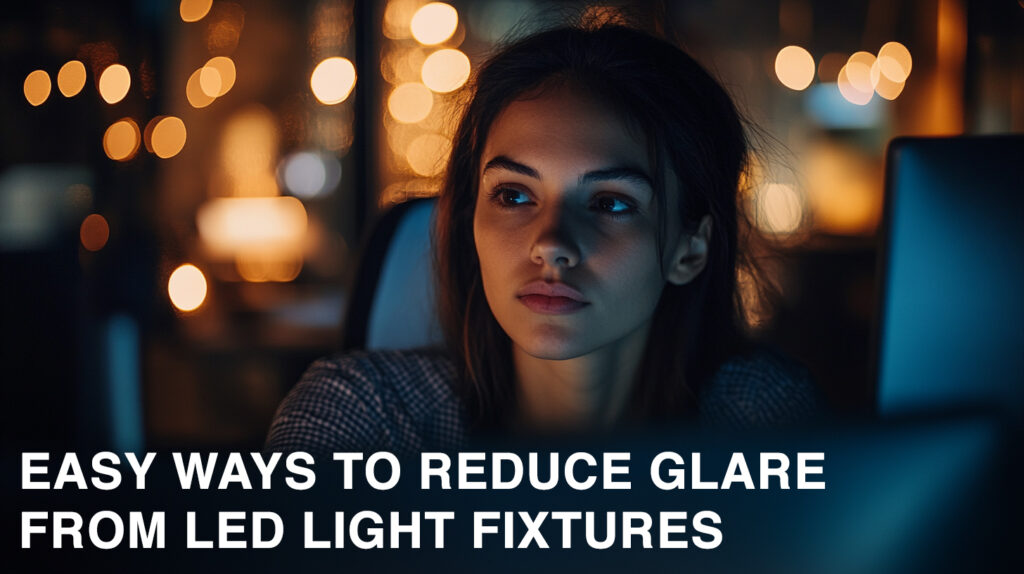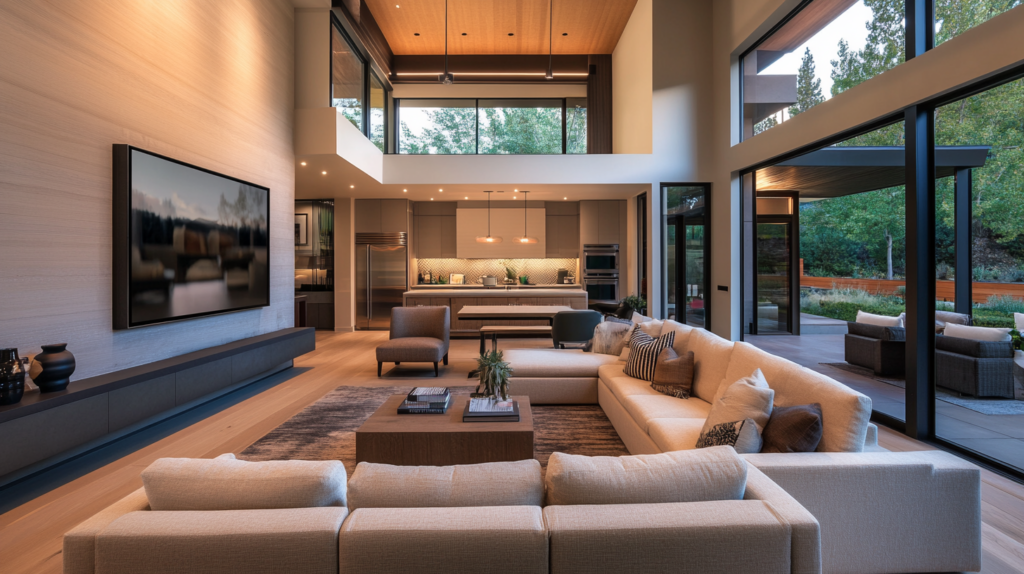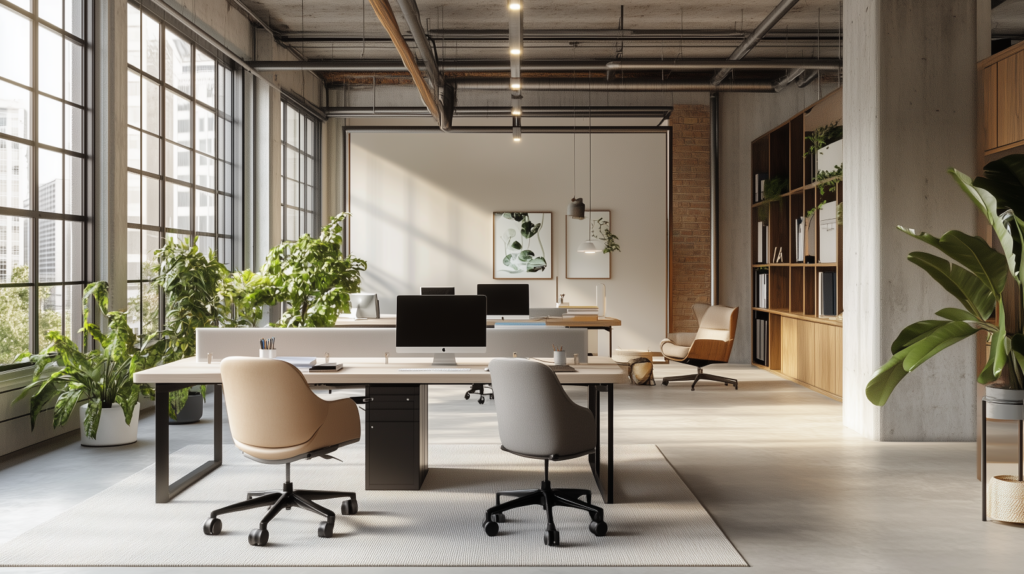Easy Ways To Reduce Glare From LED Light Fixtures October 26, 2024 – Posted in: Tutorials

Table of Contents
Are you struggling with the glare from LED lights at home or work? Excessive light glare can cause eye strain and headaches. This guide will show you simple ways to reduce this problem using anti-glare products, filters, and proper positioning of fixtures.
Let’s make your lighting comfortable!
Key Points
- Using LED anti-glare lights to reduce eye strain and bright spots.
- Filters, diffusers, lens covers, masking films, and louvers help manage light.
- Position fixtures away from direct eyes; aim at walls or ceilings.
- Choose LEDs with color temperature under 3000K if you want a cozy feel.
- Dimmers can control light intensity and reduce glare effectively.
What is Light Glare?

LED glare occurs when bright light from LEDs shines directly into your eyes. This can cause discomfort and reduce visibility. LED lights often produce more glare than filament and halogen bulbs.
High brightness, sharp light, or a poor angle of emission can lead to this issue.
The Unified Glare Rating (UGR) measures this effect. UGR values help identify safe levels of glare for different tasks. For example, office work needs a UGR below 19. Technical jobs like drawing require an even lower UGR value below 16 to avoid issues with visibility and eye strain.
Effective Methods to Reduce Light Glare

Reducing LED glare can help improve comfort and visibility. Here are some simple ways to cut down on the harsh light from LEDs.
Using LED Anti-Glare Lighting Products
Switch out old lights for anti-glare lighting products. These special type of lights cut down on overhead and extra light sources. Anti-glare solutions like frosted glass help soften the light rays, making them easier on the eyes.
Lampshades and covers absorb or spread excess light to reduce glare.
Anti-glare LED lights also lower eye strain and fatigue by blocking reflections and cutting down on bright spots. Using these lights in your home or office can make a big difference in comfort.
“Using anti-glare lights has improved visual comfort for many of our clients” says Mark from Design Lights Inc
Install Filters and Diffusers
Using filters and diffusers can be used to reduce the glare from LED lights. They manage how light spreads, making it softer and easier on the eyes.
- Filters Over LED Fixtures
- Install filters to cut down UV rays.
- Filters stop harsh light that causes glare.
- They also protect your eyes from strong light.
- Diffusers to Lower Light Intensity
- Place diffusers over LED bulbs.
- They spread the light more evenly.
- This makes the light less intense and gentler.
- Lens Covers for Light Management
- Use lens covers like prismatic or polycarbonate lenses.
- These help control how the light is distributed.
- Lens covers help in reducing strong glare spots.
- Masking Films for Extra Protection
- Apply masking films to LED panels.
- These films lower discomfort by blocking direct beams.
- They are easy to stick on any lighting fixture.
- Louvers with Parabolic Reflectors
- Fix louvers with parabolic reflectors on lights.
- Louvers direct the light away from your eyes.
- This method is effective for both indoor and outdoor lighting.
Each of these methods plays a part in making LED lighting more comfortable without losing brightness.
Optimize Fixture Positioning and Color Temperature

Good fixture placement and color temperature can reduce LED glare. Follow these tips to make your lighting more comfortable:
- Position Fixtures Correctly
- Move fixtures away from direct eye level.
- Aim lights towards walls or ceilings, not directly at people.
- Tilt outdoor lights downward to lessen glare outside.
- Glare is often caused from too few light sources or direct light.
- Choose Warmer Color Temperatures
- Use LEDs with a color temperature under 3000K (Not for office spaces).
- Warmer lights are easier on the eyes and create a cozy feel.
- Use Dimmers
- Install dimmers to adjust light intensity as needed.
- Dimming helps control brightness and reduce glare.
- Turn Off Unnecessary Lights
- Switch off lights when not in use to avoid excess brightness.
- Balance is key for reducing light glare.
- Soften LED Strip Lights
- Add covers or tapes on LED strip lights to diffuse the light.
Using these methods improves visual comfort and reduces glare from LED lights effectively.
Benefits of Reducing LED Glare

Reducing LED glare can greatly improve your lighting environment and visual experience. Read on to discover how you can achieve this.
Enhanced Visual Comfort

LED glare can hurt your eyes. It causes strain and makes it hard to see clearly. Reducing the glare of light from LED lamps helps in creating enhanced visual comfort. This prevents harsh shadows that confuse our vision.
Choosing anti-glare products is key. These lights produce low UV emissions, which help protect your eyes. Positioning fixtures well also reduces brightness directly entering the human eye.
Thus, you enjoy a more pleasant lighting experience indoors or outdoors without straining to see objects clearly, boosting both safety and focus in spaces like kitchens and offices.
Improved Productivity and Safety

Reducing LED glare can boost productivity. Glare makes it hard to see clearly, leading to eye strain and tiredness. Clearer lighting allows people to work longer without hurting their eyes.
This means better focus on tasks.
Safer environments come from reducing glare too. Good lighting helps prevent accidents by making hazards more visible. Workers are less likely to trip or run into obstacles when the light is even and soft.
This keeps everyone safer in both indoor and outdoor spaces like offices and streets.
Conclusion
Managing LED glare can be easy with the right techniques. Use anti-glare products and proper fixture positioning to improve your lighting setup. These steps will enhance comfort, raise productivity, and boost safety in both indoor and outdoor spaces.
FAQs
What are some easy ways to reduce glare from LED indoor lights?
To reduce glare from LED indoor lights, use diffusers which are semi-transparent and designed to disperse light evenly. Choose lighting fixtures with anti-glare features and opt for warm white LEDs that emit softer light.
How can I minimize glare from LED outdoor lighting?
For outdoor settings, select unidirectional and angled light fixtures to control the emission angle. Use anti-reflective coatings on lenses and install luminaires that provide low UGR (Unified Glare Rating) for reduced visual discomfort.
Can using specific types of bulbs help in reducing glare?
Yes, using bulbs like warm white LEDs instead of incandescent or halogen lamps can significantly lower glare levels. These LEDs have better luminous flux distribution and produce less direct light entering the eye.
Are there any products specifically designed to combat disability glare caused by LEDs?
Anti-glare films and optical filters are effective solutions for combating disability glare caused by high-output LED sources. These products diffuse the emitted light, making it easier on the eyes.
How does controlling light distribution help in reducing glare at stadiums or large venues?
Controlling light distribution through well-designed LED stadium lights helps focus illumination where needed while minimizing shadows around objects, thus reducing overall visual field disruption caused by excessive brightness.
What role do sensors play in managing LED streetlight glare?
Sensors can adjust the intensity of LED streetlights based on ambient conditions, thereby optimizing energy consumption while maintaining appropriate luminous flux levels to avoid causing hard-to-look-at bright spots or reflections (physics).
I have been the project manager for Modern.Place since early 2016, spending three of those years working overseas on the manufacturing & procurement side of the LED lighting industry. Constantly learning and passing on knowledge to others while excited for what the lighting industry will involve into next.

